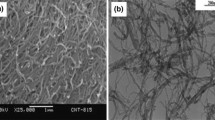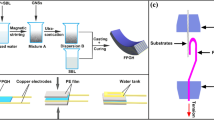Abstract
A polyarylate (PAR) substrate was first prepared by hot pressing and then carbon nanotubes (CNTs) were coated on its surface by a low-temperature spraying method. In order to eliminate the residual stress and enhance the adhesive ability between the substrate and the coated CNT layer, an optimal thermo-permeating process is proposed. The relationship between the thickness of the permeating layer and the residual stress of coating layers was investigated. Triple-layer structure models were provided to evaluate the residual stress of coating layers. The experimental results show that if the sample was treated by the optimal thermo-permeating process, its residual stress was dramatically reduced from 1.7×103 MPa to 0.45 Pa; meanwhile, its adhesive ability was intensively enhanced from 1B to 5B according to ASTM D3359 adhesion classifications.









Similar content being viewed by others
References
S. Iijima, Helical microtubules of graphitic carbon. Nature 354, 56 (1991)
M.S. Dresselhaus, G. Dresselhaus, P.C. Eklund, in Science of Fullerenes and Carbon Nanotubes (Academic Press, New York, 1996), pp. 870–918
P.J.F. Harris, Carbon Nanotubes and Related Structures (Cambridge University Press, New York, 1999)
Z.C. Wu, Z.H. Chen, X. Du, J.M. Logan, J. Sippe, M. Nikolou, K. Kamaras, J.R. Reynolds, D.B. Tanner, A.F. Hebard, A.G. Rinzler, Transparent, conductive carbon nanotube films. Science 305, 1273 (2004)
Q. Cao, Z.T. Zhu, M.G. Lemaitre, M.G. Xia, M. Shim, J.A. Rogers, Transparent flexible organic thin-film transistors that use printed single-walled carbon nanotube electrodes. Appl. Phys. Lett. 88, 113511 (2006)
A.D. Pasquier, H.E. Unalan, A. Kanwal, S. Miller, M. Chhowalla, Conducting and transparent single-wall carbon nanotube electrodes for polymer-fullerene solar cells. Appl. Phys. Lett. 87, 203511 (2005)
H. Koezuka, A. Tsumura, H. Fuchigami, K. Kuramoto, Polythiophene field-effect transistor with polypyrrole worked as source and drain electrodes. Appl. Phys. Lett. 62, 1794 (1993)
W.M. Tsang, Organic light-emitting diodes fabricated on a new transparent conducting anode: aluminum-doped zinc oxide. Ph.D. dissertation, City University of Hong, Kong (2006)
M. Kaempgen, G.S. Duesberg, S. Roth, Transparent carbon nanotube coatings. Appl. Surf. Sci. 252, 425 (2005)
J.S. Moon, J.H. Park, T.Y. Lee, Y.W. Kim, J.B. Yoo, C.Y. Park, J.M. Kim, K.W. Jin, Transparent conductive film based on carbon nanotubes and PEDOT composites. Diam. Relat. Mater. 14, 1882 (2005)
Y.I. Song, C.-M. Yang, D.Y. Kim, H. Kanoh, K. Kaneko, Flexible transparent conducting single-wall carbon nanotube film with network bridging method. J. Colloid Interface Sci. 318, 365 (2008)
S. Paul, D.-W. Kim, Preparation and characterization of highly conductive transparent films with single-walled carbon nanotubes for flexible display applications. Carbon 47, 2436 (2009)
Z.N. Yu, J.J. Zhao, F. Xia, Z.J. Lin, D.P. Zuang, J. Leng, W. Xue, Enhanced electriical stability of flexible indium tin oxide films prepared on striple SiO2 buffer layer-coated polymer substrates by magnetron sputtering. Appl. Surf. Sci. 257, 4807 (2010)
G.G. Stoney, The tension of metallic films deposited by electrolysis. Proc. R. Soc. 553, 172 (1909)
H.H. Yu, S.J. Hwang, K.C. Hwang, Preparation and characterization of a novel flexible substrate for OLED. Opt. Commun. 248, 51 (2005)
K. Kalyanasundaram, M. Grätzel, Applications of functionalized transition metal complexes in photonic and optoelectronic devices. Coord. Chem. Rev. 77, 347 (1998)
C.H. Huseh, Modeling of elastic deformation of multilayers due to residual stresses and external bending. J. Appl. Phys. 91, 9652 (2002)
A.E. Ennos, Stresses developed in optical film coatings. Appl. Opt. 5, 51 (1966)
Y.C. Lin, W.Q. Shi, Z.Z. Chen, Effect of deflection on the mechanical and optoelectronic properties of indium tin oxide films deposited on polyethylene terephthalate substrates by pulse magnetron sputtering. Thin Solid Films 517, 1701 (2009)
Acknowledgements
The authors gratefully acknowledge the funding of the research by the National Science Council of Taiwan (NSC 99-2221-E-150-046-MY2).
Author information
Authors and Affiliations
Corresponding author
Appendix
Appendix

Rights and permissions
About this article
Cite this article
Kuo, WK., Huang, SC. & Yu, H.H. Preparation of carbon nanotubes as the conductive coating layer on flexible thermal-resistant substrate by permeating method and its residual stress analysis. Appl. Phys. A 114, 1167–1173 (2014). https://doi.org/10.1007/s00339-013-7709-0
Received:
Accepted:
Published:
Issue Date:
DOI: https://doi.org/10.1007/s00339-013-7709-0




